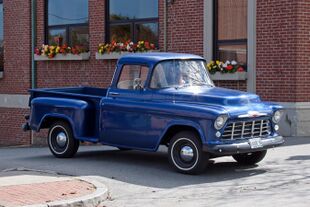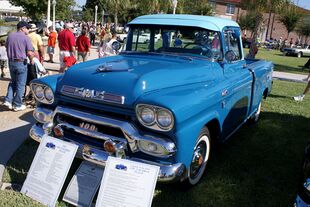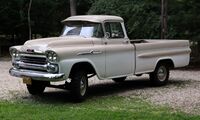Engineering:Chevrolet Task Force
| Chevrolet Task Force Series | |
|---|---|
 1956 Chevrolet Task Force (3100) | |
| Overview | |
| Manufacturer | Chevrolet (General Motors) |
| Also called | Task-Force Apache Cameo/Cameo Carrier Suburban Viking (medium-duty) Spartan (heavy-duty) GMC Blue Chip Series |
| Production | 1955–1959 |
| Assembly | (main Chevrolet plant) Flint Truck Assembly, (Flint, Michigan) (branch assembly) Baltimore Assembly, (Baltimore, Maryland) Janesville, Wisconsin, (Janesville Assembly) Lakewood Assembly, Lakewood Heights, Atlanta, Georgia Leeds Assembly, Leeds, Kansas City, Missouri Norwood Assembly, Norwood, Ohio Oakland, California, (Oakland Assembly) (Chevrolet and GMC) Pontiac West Assembly (Pontiac, Michigan) (GMC only) St. Louis Truck Assembly, (St. Louis, Missouri) North Tarrytown Assembly, North Tarrytown, New York Van Nuys Assembly (Van Nuys, California) Oshawa Truck Assembly (original location) (Oshawa, Ontario, Canada) GM Argentina (Buenos Aires, Argentina) |
| Body and chassis | |
| Class | Pickup truck, commercial truck |
| Body style | 2-door truck |
| Layout | Front engine, rear-wheel drive / four-wheel drive |
| Platform | GM A platform |
| Powertrain | |
| Engine | |
| Transmission | 3-speed manual 4-speed manual 4-speed Hydra-Matic automatic |
| Dimensions | |
| Wheelbase | 114.0 in (2,896 mm) 123.0 in (3,124 mm) 172.0 in (4,369 mm) |
| Chronology | |
| Predecessor | Chevrolet Advance Design |
| Successor | C/K Series |
The Chevrolet Task Force (or in some cases, Task-Force) is a light and medium-duty truck series by Chevrolet, their first major redesign since 1947. Its GMC counterpart was the Blue Chip series. It was billed as being more stylish compared to the earlier Advance Design Series while still maintaining its rugged durability. First available on March 25, 1955, these trucks were sold with various minor changes over the years until 1959, when the C/K Series trucks replaced the Task Force models for 1960.
History
GM redesigned their truck line for the second half of 1955, but sold both designs that year; the previous design became known as the 1st Series, and the all-new design as the 2nd Series. Commercial trucks and various other heavy duty models were also available.[1] Chevrolet and GMC named their new series independently.
| Manufacturer | 1955 2nd Series - 1959 Series | 1947 - 1955 1st Series |
|---|---|---|
| Chevrolet | "Task Force" | "Advance Design" |
| GMC | "Blue Chip" (short for "Blue Chip Money Makers") | "New Design" |
The trucks were differentiated by running gear and interiors; Chevrolet used Chevrolet engines, and GMC used GMC inline-sixes and Pontiac V8s (Oldsmobile V8s for heavy-duty trucks).
For the first time in GM history, trucks were available with optional power steering, power brakes, and V8s. A column-shifted 3-speed manual transmission was standard, with an optional floor-shift-4 speed manual or Hydramatic automatic. The electrical system got an upgrade to 12 volts.
The new body featured the truck industry's first wrap-around windshield,[2] and an optional wrap-around rear window for Deluxe cab models.[3] Headlights became integrated into the fenders. The cab is taller in size, and in-cab steps replaced the running boards of previous models. A "step" between the cab and rear fender aided access to items inside the pickup bed. Redesigned bed fenders were carried through the next generation body that ended in 1966.
Differences
1955 2nd Series: First year for new body style. Fenders have single headlights and a one-piece emblem is mounted below horizontal line on fender.[4] Beds are 6.5 ft (2.0 m) and 7.5 ft (2.3 m); 1955 was the only year for the mid-length 7-foot bed. The GMC inline-6 remained 6V for 1955 only.
1956: Wider hood emblem. Two-piece fender emblems are mounted above horizontal fender line. Last year for eggcrate grille.
1957: Only year for more open grille. Hood is flatter with two spears on top, similar to the 1957 Bel Air. Fender emblems are still above fender line, but are now oval-shaped, as opposed to previous versions in script.
1958: All light-duty trucks are now called "Apache", medium-duty trucks called "Viking", and heavy-duty trucks called "Spartan". First year for factory-equipped air conditioning. Significant redesign of front end, featuring a shorter/full-width grille, four headlights instead of the previous two, and Parking lights are now in the grille instead of being in the front of the fender. The hood is similar to 1955/1956 models, but with a flat "valley" in the middle. A new "styleside" all-steel bed replaces the Cameo/Suburban versions; called "Fleetside" by Chevrolet and "Wideside" by GMC, available in 6.5 ft (2.0 m) and 8 ft (2.4 m) lengths. For 1958, GM was promoting their fiftieth year of production, and introduced Anniversary models for each brand (Cadillac, Buick, Oldsmobile, Pontiac, and Chevrolet[5]); the trucks also received similar attention to appearance, but staying essentially durable, with minimal adornment.
1959: Minimal changes from 1958, the most apparent was a larger and more ornate hood emblem and redesigned badging on the fenders. This was the last year that the NAPCO (Northwestern Auto Parts Company) "Powr-Pak" four-wheel drive conversion could be factory ordered.
1960: The series was dropped, being replaced by the C/K line.
Gallery
Variants
Cameo Carrier/Suburban Pickup
| Chevrolet Cameo Carrier | |
|---|---|
 1959 GMC Suburban Pickup | |
| Overview | |
| Model years | 1955-1959 |
| Body and chassis | |
| Layout | Front engine, rear-wheel drive / four-wheel drive |
| Platform | GM A platform |
| Powertrain | |
| Transmission | 3 or 4-speed manual 3-speed Hydramatic |
| Dimensions | |
| Wheelbase | 114 in (2,896 mm) |
The mid-1955 introduction of Chevrolet's Cameo Carrier pickup truck helped pave the way for the Fleetside. The Cameo offered an array of car-like features that included passenger-car styling, fiberglass rear fenders, two-tone paint, a relatively luxurious interior, as well as an optional V8 engine, automatic transmission, and power assist steering.[6] As always, there was a GMC version offered during the same time, called the GMC Suburban Pickup, with many similar features offered on the Chevrolet. In 1957, a special version was made for GMC to be shown at national car shows called the Palomino,[7] which had a Pontiac 347 cu in (5.7 L) V8 installed, borrowed from the 1957 Star Chief.
Other pickup truck producers, including Ford, Dodge, Studebaker and International, began to offer flush-side cargo boxes on some of their 1957 models, such as the Dodge C Series, and the 1960 Studebaker Champ. Though GM replaced the Cameo Carrier and Suburban Pickup with the Fleetside and Wideside before the 1950s were over, in time, pickup trucks with flush bodies and wider beds would become the dominant standard throughout the industry.
Utility vehicles
The Task Force trucks formed the basis of the fourth-generation Chevrolet Suburban/GMC Carryall. Competing against the International Travelall and the Dodge Town Panel/Town Wagon, the Suburban became a Chevrolet nameplate (as GMC adopted the Carryall nameplate).
While marketed solely as a two-door utility wagon, the Suburban was offered in 1⁄2-ton 3100 and a 1-ton 3800 Suburban panel van was offered as an option. 3⁄4-ton 3600 Suburbans and Panel trucks were not available. Unlike the Advance Design-era trucks, there were no Canopy Express models offered.
References
- ↑ "1955 Chevrolet truck brochure". 1955. https://www.gmheritagecenter.com/docs/gm-heritage-archive/historical-brochures/chevrolet-trucks/1955-Chevrolet-Truck.pdf.
- ↑ Bunn, Don. "Chevrolet Trucks: Segment Six: 1955-1959 Early V8 Pickups". PickupTruck.com. http://www.pickuptruck.com/html/history/chev_segment6.html.
- ↑ "LMC Truck Catalog", Winter 2007/2008
- ↑ "What Year is My Truck?", Classicparts.com. Retrieved on July 2, 2008.
- ↑ Image of 50th Anniversary promotional photo
- ↑ Auto Editors of Consumer Guide (2007-10-17). "1955 Chevrolet Cameo Carrier". auto.howstuffworks.com. http://auto.howstuffworks.com/1955-chevrolet-cameo-carrier.htm.
- ↑ "1957 GMC Palomino". 1955 GMC Truck Site. https://oldchevytrucks.com/blog/index.php/2007/03/1957-gmc-palomino.
 |



























